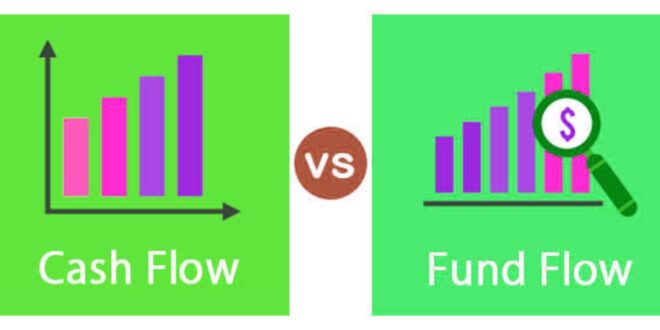Introduction
1. Financial Metrics: The Heartbeat of Business
In today’s fast-paced business environment, understanding financial metrics is no longer an option, it’s a necessity to Cash Flow vs. Fund Flow. These metrics provide invaluable insights, painting a clear picture of a company’s health and its future prospects. They act as the backbone of informed decision-making, ensuring that businesses stay afloat and thrive in competitive markets.
2. Cash Flow vs. Fund Flow: Clearing the Fog
The realm of financial metrics is vast, and amidst its vastness, the distinction between Cash Flow and Fund Flow often gets blurred. These two terms, though sounding similar, have distinct characteristics and applications. While Cash Flow offers a snapshot of money moving in and out of a business, Fund Flow delves deeper, analyzing the source and application of funds. It’s vital to understand this difference to steer your business in the right direction.
3. Common Confusions Demystified
It’s not uncommon for even seasoned professionals to confuse Cash Flow with Fund Flow. But fear not! Our blog aims to dissect these terms, shedding light on their unique aspects, applications, and significance. With the knowledge we impart, you’ll no longer be in the dark when it comes to these essential financial metrics.
Understanding Cash Flow

Definition of Cash Flow:
- Cash Flow, in its simplest form, is the movement of cash into and out of a business. Imagine it as the business’s bloodstream, with cash flowing in from various sources such as sales, investments, or loans. Simultaneously, cash flows out to cover expenses like salaries, rent, or loan repayments. It’s this dynamic inflow and outflow that determines the liquidity position of a business, signaling its capacity to meet short-term obligations and invest in future growth.
Types of Cash Flow:
1. Operating Cash Flow: The Core of Business Dynamics
- At the heart of any business lies its primary activities – selling products, providing services, or both. Operating Cash Flow is the mirror reflecting cash generated from these very core functions. Think of it as the company’s regular heartbeat, keeping it alive and thriving. When this number is positive, it’s a testament to the fact that the foundational elements of the business are solid and that the company can sustain its operations without external financial help.
2. Investing Cash Flow: Venturing Beyond the Routine
- Every business, at various stages, needs to look beyond its routine activities. This is where Investing Cash Flow comes into play. Whether it’s the cash obtained from selling a piece of machinery or the funds invested in buying stocks of another company, this category captures it all. It’s a snapshot of how a business is strategically positioning itself for the future. While a negative value here might raise eyebrows, it often indicates that the company is heavily investing in future growth, a sign of ambition and forward-thinking.
3. Financing Cash Flow: Navigating External Financial Waters
- Not every need of a company can be met through its operations or investments. Sometimes, external financing routes become necessary. Financing Cash Flow tracks this exact journey. From acquiring loans to issuing shares, it provides a window into how a business is leveraging external financial resources. A positive number here can signal that the company is actively raising capital, while a negative one might show that it’s in a phase of settling debts or rewarding its stakeholders.
Importance of Cash Flow:
Liquidity Measurement: The Financial Lifeline
- Cash Flow’s ability to measure liquidity is akin to checking a person’s pulse – vital and revealing. Liquidity paints a clear picture of a company’s capability to handle its short-term commitments without breaking a sweat. In the vast expanse of “Cash Flow vs Fund Flow”. This liquidity metric, derived from Cash Flow, is a testament to a company’s ability to thrive even in turbulent financial waters. Companies with robust liquidity are like ships with sturdy anchors, capable of weathering financial storms and ensuring stakeholders’ confidence remains unwavering.
Assessing Operational Efficiency: Beyond the Surface
- While profitability is often celebrated, it’s the operating cash flow that provides a candid look into the day-to-day health of a business. A positive operating cash flow doesn’t just mean money in the bank; it’s an applause-worthy reflection of efficient business operations. This facet of Cash Flow peels back layers, highlighting that the core business – be it selling products or rendering services – is not just functioning but flourishing. In the broader dialogue of “Cash Flow vs Fund Flow”. This indicator certifies that a company’s heart – its operations – is beating strong and steady.
Understanding Fund Flow

Definition of Fund Flow:
- In the vast arena of finance, Fund Flow emerges as a comprehensive term, encapsulating the movement of financial resources. More than just the ebb and flow of cash, it represents the broader dynamics of incoming and outgoing funds. Imagine Fund Flow as the intricate web of financial transactions that a business experiences – encompassing everything from capital infusion, earnings, expenses, loans, and investments.At its core, Fund Flow offers a holistic view of the financial health and mobility of a company. Whereas Cash Flow hones in on the liquidity derived from operations, investments, and financing, Fund Flow paints the bigger picture, capturing the totality of a company’s financial movements.In the nuanced narrative of “Cash Flow vs. Fund Flow”, understanding Fund Flow is tantamount to observing the vast financial orchestra at play – each movement, each transaction, contributing to the symphony of a company’s fiscal journey.
Components of Fund Flow:
1. Sources of Funds: The Financial Wellspring
Every business, from nascent startups to established conglomerates, requires financial fuel to propel its ambitions forward. The ‘Sources of Funds’ stands as a testament to this financial genesis. It’s the reservoir from which companies draw their monetary sustenance.
- Long-term loans: These are commitments where businesses borrow substantial amounts, often from financial institutions, with a promise to repay over extended periods. They offer the breathing room to strategize, innovate, and expand.
- Issue of shares: When a company decides to share a piece of its equity pie with the public or specific investors, it issues shares. This not only raises capital but also extends ownership, binding shareholders in the company’s journey.
2. Applications or Uses of Funds: Directing the Financial Flow
Having resources is one thing; utilizing them effectively is another. The ‘Applications or Uses of Funds’ component of Fund Flow maps out the destinations where the accumulated funds are channeled.
- Repayment of loans: Just as rivers eventually meet the sea, loans too have their endpoint. Companies allocate funds to settle these obligations, ensuring they maintain their financial credibility and trust.
- Purchase of fixed assets: To bolster operations or expand their horizons, companies often invest in fixed assets like machinery, property, or technology. This allocation not only augments their operational capacity but also lays the foundation for future growth.
Importance of Fund Flow:
1. Evaluates the Financial Strategy: Charting the Business Course
In the dynamic world of business, every decision, every strategy is a reflection of a company’s vision. The Fund Flow stands as a barometer, gauging the effectiveness of these choices. By mapping out how funds are sourced and subsequently deployed, it provides a clear snapshot of a company’s fiscal strategy.
- Identifying sources: Whether it’s through long-term loans or the issuance of shares, Fund Flow highlights where the financial impetus originates. It’s a reflection of a company’s external financial relationships and the trust bestowed upon it by stakeholders.
- Tracing applications: Understanding where funds are channeled – be it for asset acquisition or debt repayment – offers insights into the company’s growth trajectory, risk appetite, and operational priorities.
2. Assists in Future Planning: Envisioning Tomorrow
Beyond assessing the present, Fund Flow acts as a beacon, illuminating the path ahead. With its comprehensive view of the financial architecture, it enables businesses to forecast, strategize, and adapt.
- Financial structure insights: By providing a bird’s-eye view of current financial allocations, Fund Flow allows businesses to identify strengths, vulnerabilities, and opportunities in their financial structure.
- Anticipating shifts: Markets evolve, and so do business strategies. With a keen understanding of Fund Flow, companies can better anticipate potential financial shifts, ensuring they remain agile and responsive in an ever-changing economic environment.
Key Differences Between Cash Flow and Fund Flow
Nature:
- Cash Flow: Focuses solely on cash transactions.
- Fund Flow: Encompasses wider financial resources, not just cash.
Purpose:
- Cash Flow: Assesses liquidity and operational efficiency.
- Fund Flow: Evaluates financial decisions, structure, and strategy.
Periodicity:
- Cash Flow: Typically prepared for shorter durations (e.g. monthly, quarterly).
- Fund Flow: Can be prepared for longer durations (e.g. annually).
Detailed Breakdown:
Highlight the components of both statements to visually compare.
Cash Flow vs. Fund Flow: Understanding the Difference with Real-life Examples
Cash Flow and Fund Flow are two critical financial concepts often used in business and finance. However, the difference between them can be a bit puzzling. Let’s break it down with simple, relatable examples.
Imagine you own a bakery. Cash Flow captures the actual inflow and outflow of cash. Let’s say in a week, you earned $1000 from sales but had to pay $600 for ingredients, rent, and salaries. Your net cash flow for the week is $400 ($1000 inflow – $600 outflow).
On the other hand, Fund Flow looks at the broader picture. It includes both cash and non-cash items. Suppose, in the same week, you also bought a new oven worth $200 on credit, to be paid in a month. While this doesn’t impact your cash flow for the week, your fund flow would show a $200 outflow, reflecting the commitment to pay later.
Why It Matters for Businesses and Investors
In the world of finance, understanding the difference between “Cash Flow vs Fund Flow” is more than just a matter of terminology. These concepts offer distinct insights and play a crucial role in shaping the strategies of businesses and the decisions of investors.
1. Significance in Decision-Making:
- Both Cash Flow and Fund Flow statements serve as pivotal tools for businesses. Cash Flow gives a clear picture of a company’s liquidity and its ability to cover immediate expenses. It addresses the query: “Is the business equipped to handle its near-term financial commitments?” Fund Flow. On the other hand, offers a broader perspective, highlighting how a company is sourcing its funds and where those funds are being applied. This is vital for understanding the overall movement and allocation of resources.
2. Importance for Investors:
- When investors evaluate a company’s financial health, “Cash Flow vs. Fund Flow” is at the forefront. A positive cash flow indicates that a company is generating more cash than it’s spending, which can be a sign of profitability and the ability to return value to shareholders. Fund Flow, however, can reveal if the company is over-relying on borrowed funds, potentially indicating a higher financial risk. A balanced and healthy fund flow can be a green flag for investors, suggesting effective management and growth potential.
3. Role in Business Strategy and Long-Term Planning:
- Cash Flow analysis is pivotal for short-term operational decisions, ensuring there’s enough liquidity for day-to-day operations. Meanwhile, Fund Flow plays an indispensable role in shaping long-term business strategies. For instance, if a company consistently finds its major fund source to be debt, it might reconsider its strategy to focus more on equity financing or internal accruals.In conclusion, while both concepts differ in scope, they offer complementary insights. Recognizing the nuances between “Cash Flow vs. Fund Flow” enables businesses to craft sound financial strategies and allows investors to make well-informed decisions.



